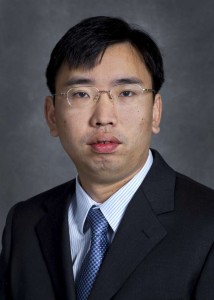2014 Spring Symposium
Feng Jiao
Department of Chemical and Biomolecular Engineering
University of Delaware
Newark, DE 19716
jiao@udel.edu
Abstract — Solar fuel production is an important technological challenge, considering that the energy of sunlight that strikes the earth’s surface in an hour is sufficient to meet our energy demands for a year. Irrespective of the approach that is pursued, oxygen evolution from water is the critical reaction, because water is the only cheap, clean and abundant source that is capable of completing the redox cycle for producing either hydrogen (from H2O) or carbonaceous fuels (from CO2) on a terawatt scale. Here, we will show our recent studies in mesoporous spinel systems, which suggest the metal sitting at the octahedral site has huge impact on the water oxidation activity of spinel catalysts. Another topic will be discussed in the presentation is the development of selective and robust CO2 reduction electrocatalyst. We will present a nanoporous Ag electrocatalyst, which is able to electrochemically reduce CO2 to CO with a ~92% selectivity at a rate (i.e. current) of over 3000 times higher than its polycrystalline counterpart under a moderate overpotential of less than 0.50 V. Such an exceptionally high activity is a result of a large electrochemical surface area (ca. 150 times larger) and intrinsically high activities (ca. 20 times higher) compared to polycrystalline Ag.
 Biography — Feng Jiao obtained his BS in chemistry at Fudan University (2001) and his PhD degree in Chemistry at University of St Andrews (Scotland, 2008), before moving to Lawrence Berkeley National Laboratory as a postdoc scholar. He spent two years in Berkeley developing solar fuel technology and joined in the Chemical and Biomolecular Engineering Department at the University of Delaware as an assistant professor in 2010. He has already published more than 35 journal papers in leading scientific journals, such as Nature Communications, J. Am. Chem. Soc., and Angew. Chem. Int. Ed. His research activities include synthesis of nanoporous materials and their potential applications in energy storage and conversion.
Biography — Feng Jiao obtained his BS in chemistry at Fudan University (2001) and his PhD degree in Chemistry at University of St Andrews (Scotland, 2008), before moving to Lawrence Berkeley National Laboratory as a postdoc scholar. He spent two years in Berkeley developing solar fuel technology and joined in the Chemical and Biomolecular Engineering Department at the University of Delaware as an assistant professor in 2010. He has already published more than 35 journal papers in leading scientific journals, such as Nature Communications, J. Am. Chem. Soc., and Angew. Chem. Int. Ed. His research activities include synthesis of nanoporous materials and their potential applications in energy storage and conversion.